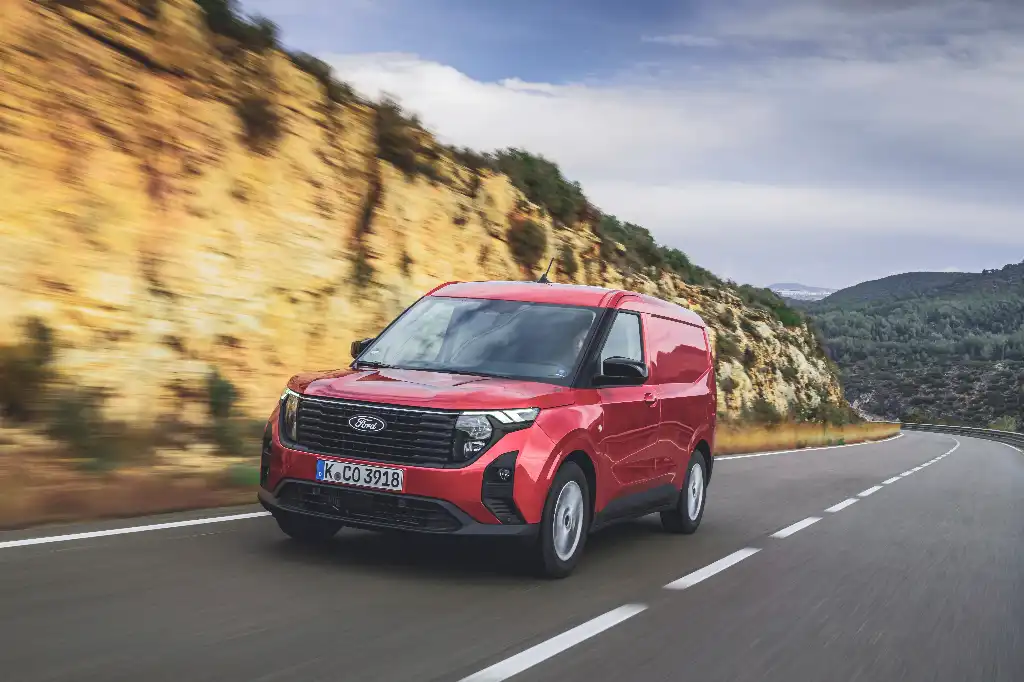
The Ford Transit Courier has undergone something of a transformation, hitting the gym, pumping some iron and becoming a bigger, badder and better version of its former self.
The formerly Fiesta-based van has been plumped up for its second-generation, adopting the chassis of Ford's B platform SUV, the Ford Puma, to kickstart a significant revision of the Ford Transit Courier dimensions. Although still the smallest Transit van model in the formidable range that includes the large two-tonne Ford Transit, Ford E-Transit, Ford Transit Custom and Ford Transit Connect, the latest Ford Transit Courier now sits uncomfortable close to its nearest sibling in terms of size.
Previous Ford Transit Courier had a length of just over 4.16m, while the new model measures more than 4.3m in length. While that doesn't sound like a great deal, it's a big increase from the market the previous model was meant to cover. In order to understand that it's time for a quick history lesson...
The price at launch of the Transit Courier is £16,200 ex VAT for the entry-level Transit Courier Leader model. That's with a petrol 1-litre EcoBoost engine.
The cheapest diesel Transit Courier van is 1.5-litre EcoBlue in Leader trim which costs £17,450. The on the road price, including VAT for the diesel van is £23,015.20
The benefit in kind cost for a Transit Courier is flat rated at £66 per month for those paying 20% tax and £132 per month for those in the 40% tax bracket.
While the Courier name had been used by Ford in the past all over the world, the first Ford Transit Courier was launched as an alternative to the Ford Fiesta Van ahead of it being discontinued.
The relaunched Transit Courier was a continuation of Ford's Courier van of the nineties which was a car derived van. Like its predecessor it was very much a B-segment vehicle, and despite more than doubling the load volume of a Fiesta Van it was still a small van which could just about be compared with the likes of the Fiat Fiorino, Citroen Nemo and Peugeot Bipper. [Nerd fact - around the same time, there was once a Renault Kangoo Compact that had a very similar footprint and load area to the Transit Courier, as well as a Mercedes-Benz Citan version.] The Fiesta Van it was replacing was also 200mm smaller than the previous Transit Courier. That means that upping the size of this latest version to 4337mm Ford is most definitley, taking it from its B segment roots.
The Ford Transit Courier will now instead occupy the lower end of the C-segment van class. What that means is that it's bigger. But it's bigger in every dimension. It has had a small increase in height of 57mm, added 180mm in length and 36mm in width.
It may not sound like much, but it has had a big impact on the usability of the van, overall. While all versions of the Transit Courier have been box bodied panel vans, they are car-derived albeit not in the true sense of the word.
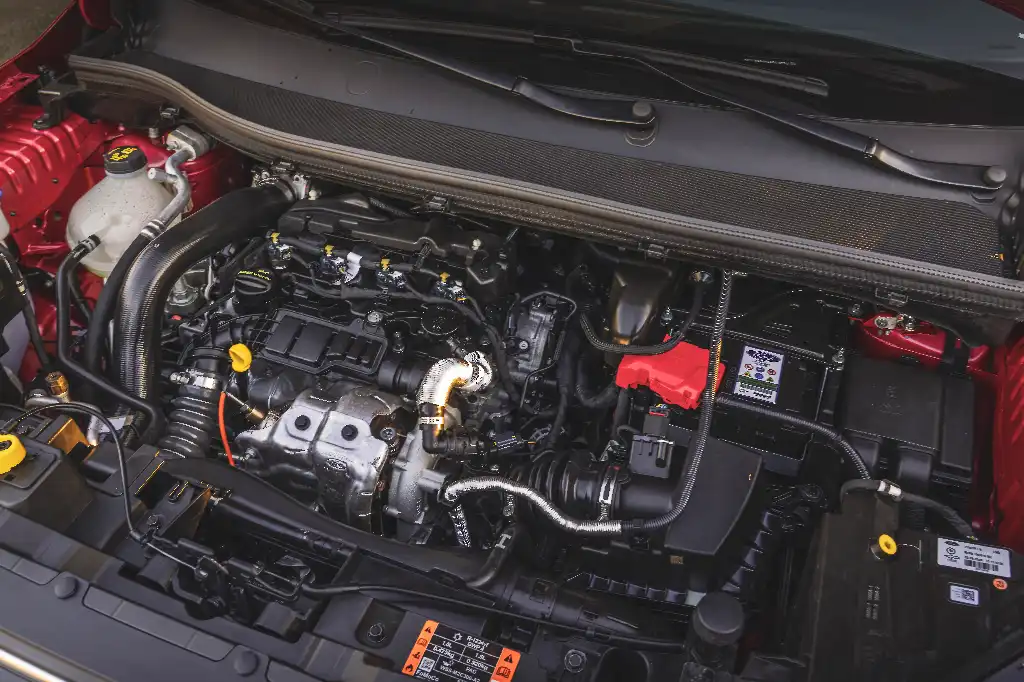
The Ford Transit Courier is available with petrol, diesel and electric powertrain options.
There's just one engine for each fuel type with a 1.5-litre EcoBlue diesel engine producing 123hp (125PS) and two outputs of 99hp (100PS) and 123hp (125PS) from the same 1-litre EcoBoost petrol engine.
Outputs for the electric van are still to be revealed. Despite there being a hybrid version in the similar Ford Puma passenger car, there are no plans for a Ford Transit Courier hybrid. Or a Tourneo Courier hybrid model either.
Ford's second-generation Transit Courier is built in Craiova, Romania, on the same line as the Ford Puma crossover SUV.
The plant is part of a €490m investment by Ford Otosan to build the Transit Courier, Tourneo Courier and Puma in the same plant.
The first-generation Transit Courier was built in Kocaeli, Turkey, by Ford Otosan.
Yes. The petrol EcoBoost engine gets a 7-speed automatic option, which is also available on the Ford Tourneo Courier passenger car variant. The diesel has to make do with a 6-speed manual and no auto. The petrol also gets a six-speed manual and electric versions will have a single speed transmission.
The best Ford Transit Courier is the diesel engine which comes with a manual 6-speed gearbox. That's because the diesel van has much greater torque levels making it more suited to a commercial vehicle.
Despite only have 99hp, the 1.5-litre EcoBlue diesel engine gets 250Nm of torque from 2000rpm. Compared to the 1-litre petrol EcoBoost it's a big difference. The 1-litre EcoBoost engine has 170Nm at 1400rpm as standard, more than 30% less than the diesel, but thanks to its clever boost technology there's a slight improvement. The 100PS EcoBoost has 180Nm at 1600rpm to 3500rpm, while the 125PS EcoBoost gets 200Nm between 1750rpm to 2500rpm when on overboost.
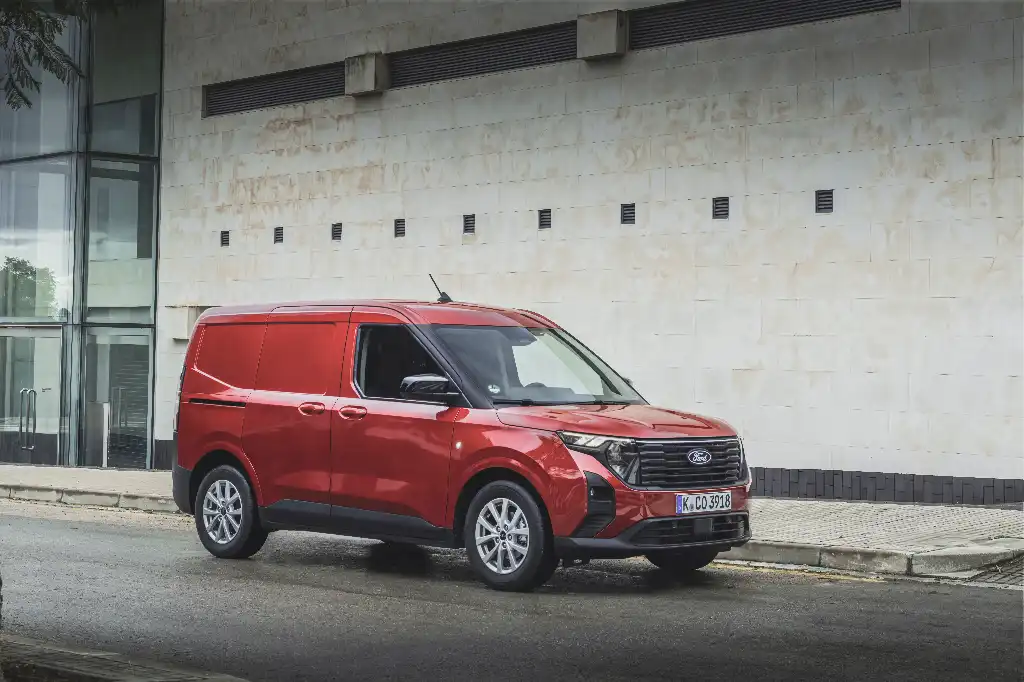
It's still not enough to make the petrol feel like a viable commercial vehicle. Especially on one that is designed to carry as much as 845kg. The petrol feels a bit lacking, even when tested with just 250kg on board. It also comes with a fuel consumption penalty.
The diesel Ford Transit Courier with EcoBlue engine has a WLTP claimed fuel economy of 55.4mpg - depending on which of the four trim levels you choose.
The petrol Ford Transit Courier with EcoBoost engine has a WLTP claimed fuel economy of 43.5mpg.
A high-revving petrol engine also means more noise in the cabin. While neither the petrol or the diesel are noisy, the need to really stretch the petrol's engine if either fully laden or in a rush, does add to the noise.
No, it doesn't quite share the same look as the rest of the range - most noteably the Ford Transit Custom from the same time period. That's because it's taken quite a few of its design cues from the Ford Explorer front end. The interior, however, looks very similar to the Transit Custom. But there are some noticeable differences.
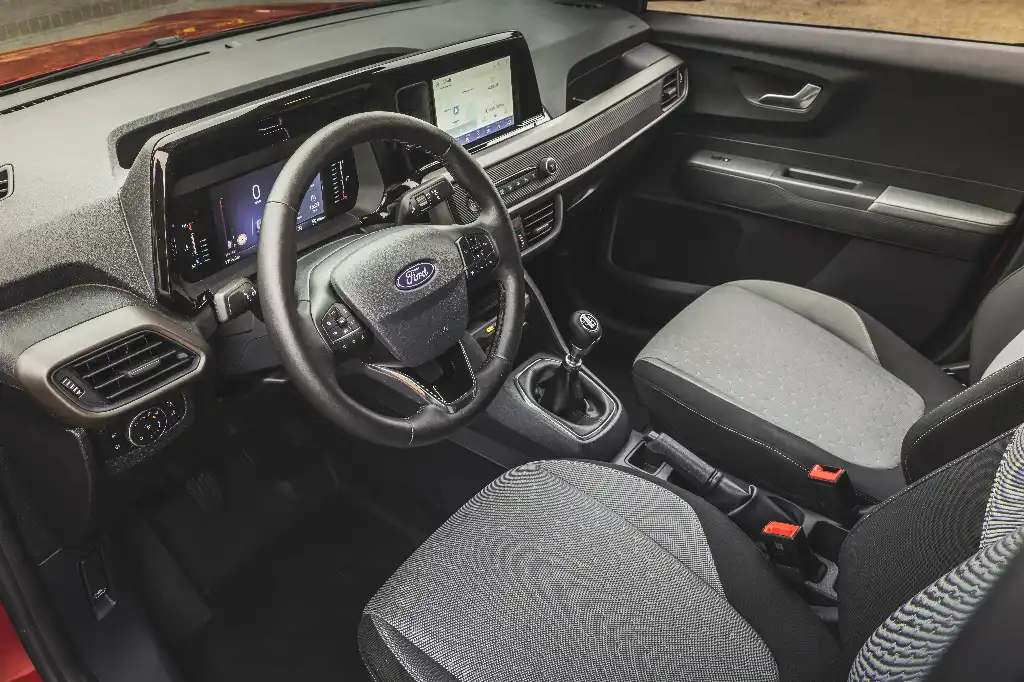
At a glance, the Ford Transit Courier is much like the Transit Custom. On closer inspection you'll see that a few corners have been cut. The Courier is an entry-level van. If you were to compared it to another manufacturer, it's very similar to the approach Renault took with the Renault Kangoo and the Renault Express. The Kangoo is the premium offering, the Express (not available in the UK) is the cheaper and slightly smaller van.
If you think of the Courier in the same way you're on the money. It’s been made to a price point - which is fair enough - in order for it to sit below its sibling, and the competition. But it's reflected in some of the plastics in the the interior. Like the Transit Custom there's a smart-looking piano black surround key parts of the dash. But elsehwere there are some cost savings with harder plastics and a noticeable and annoying lack of buttons for important controls like the heating.
What little physical buttons remain are on a corrugated strip of plastic that runs across the cabin. Instead, the important stuff like temperature controls and fan speed are adjusted through the 8-inch touchscreen.
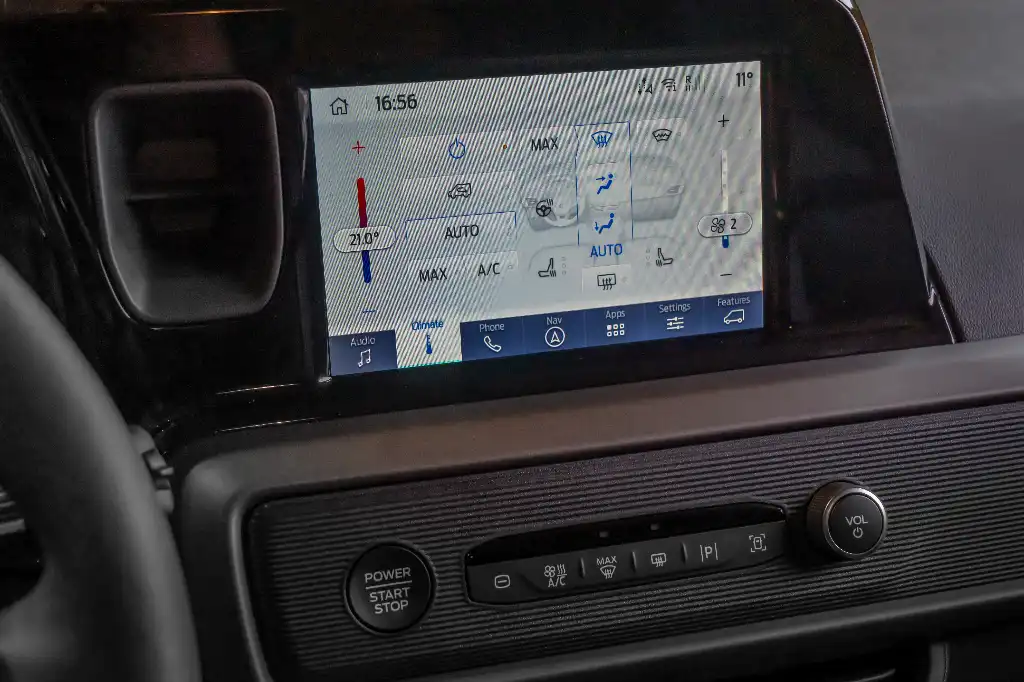
It's a familiar infotainment system with Ford's SYNC 4 multimedia interface allowing wireless smart phone integration for Apple CarPlay and Android Auto.
Ahead of the driver there is a digital trip display on the instrument cluster and a steering wheel with controls for much of the multimedia system as well as cruise control.
There's also a firm but supportive seat, which has plenty of travel for taller drivers. The steering wheel is also rake and reach adjustable.
Visibility forwards and to the rear is also excellent thanks to decent sized mirrors that are electronically adjustable and foldable.
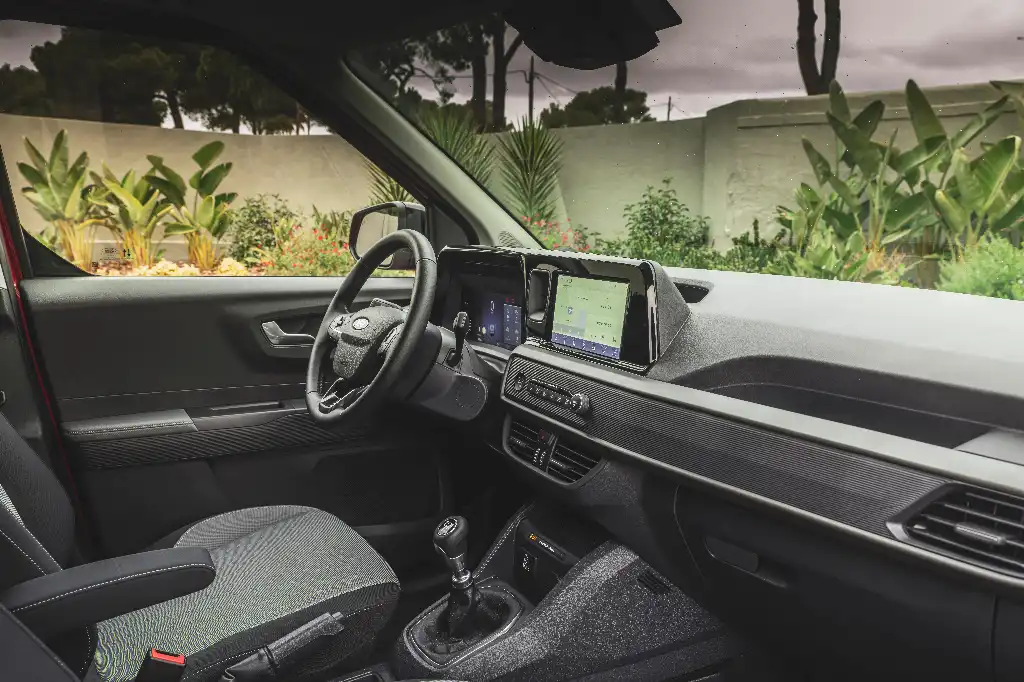
The Courier feels larger in every aspect, but space in the cabin isn't as abundant as you might hope.
There are many locations for small item storage but for anything larger than a set of keys it becomes problematic. There's central storage and cup holder around the handbrake, a long shallow shelf across the dash and an interestingly designed compartment to the side of the multimedia screen.
It looks a coin shelf but has been designed with mobile phones in mind. It provides a point for a mount to be fixed. This is an alternative to using air vents. It also helps solves the problem of a location for a smartphone as a low cost option to the costly navigation. Or, as previously mentioned it's possible to mirror your smartphone to the touchscreen.
There’s also an overhead storage tray, which is the best location for larger items and a well-sized glovebox for such a small van. Door pockets are capable of taking small bottles.
Increasing the size of the Ford Transit Courier has resulted in substantial improvements to the load area of the van. The rear loadspace is capable of taking up to 2.9m3. Maximum load lengths are up to 1802mm but the addition of a loadthrough bulkhead increases capacity to 2667mm.
Two Euro pallets can be transported side by side in the rear thanks to its 1220mm width between its wheelarches. Overal width across the rear is 1535mm at its widest.
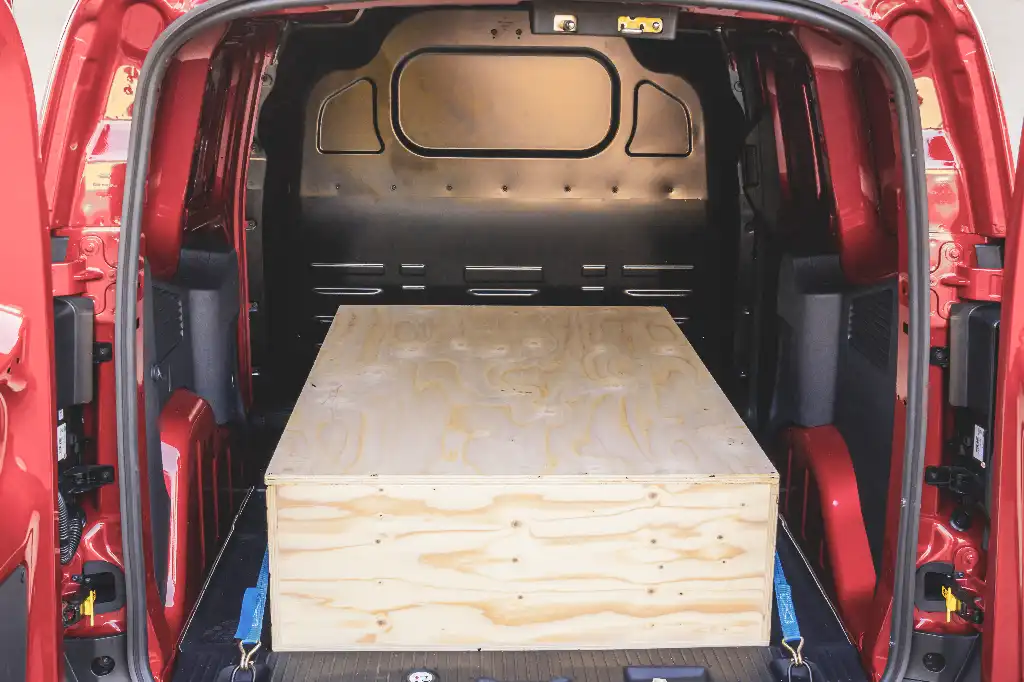
The Ford Transit Courier is available in two different gross vehicle weights. That has allowed Ford to give customers a high payload option of up to 845kg. Regular vans have a payload range of between 615kg and 676kg for petrol and diesel ICE (internal combustion engine) vans. The variance in payload capacity is due to the different engine and trim specs.
The best payload can be had on a petrol engine automatic Transit Courier in entry-level Leader trim.
The high gross vehicle weight option adds around 170kg of additional payload. At launch, the high payload option cost just £150.
The basic payload for a Transit Courier van is 615kg, however, a high payload option of up to 845kg is available. This adds 170kg to the overall payload of the van.
The Ford Transit Custom has a towing capacity of up to 1.1 tonnes for diesel vans. Petrol vans can tow 1000kg. Electric vans can tow 750kg.
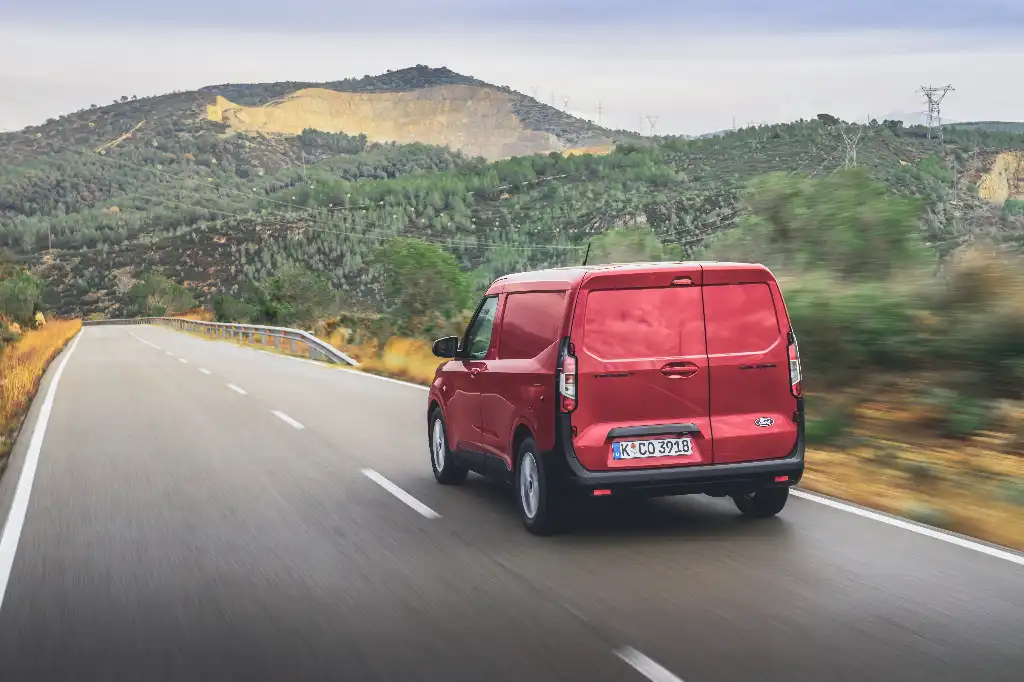
The Ford Transit Courier is almost in a class of its own. But, there is also competition from slightly larger vans like its Ford Transit Connect sibling, and small vans from Stellantis. Buyers might also consider other car-derived van conversions like the Suzuki Jimny Commercial - although it is much smaller.
The most appropriate competitor is probably the Citroen Berlingo and Peugeot Partner. But, all vans from Stellantis, which include the Fiat Doblo Cargo and the Stellantis-made Toyota Proace City, measure around 4.4m in overall length. They have a 3.3m3 loadspace which betters the Transit Courier's 2.9m3 rear. The Stellantis ProOne vans can also carry longer overal lengths.
Despite the Transit Courier getting a load-through bulkhead, increasing capacity from 1802mm to 2667mm, competitors can do more. That's because the Ford bulkhead stops under the bench seat, whereas Berlingo and others goes through to the footwell. Importantly, like the Ford Transit Connect (which is bigger still than the Stellantis vans) the competitions has long-wheelbase models. Which the Courier does not.
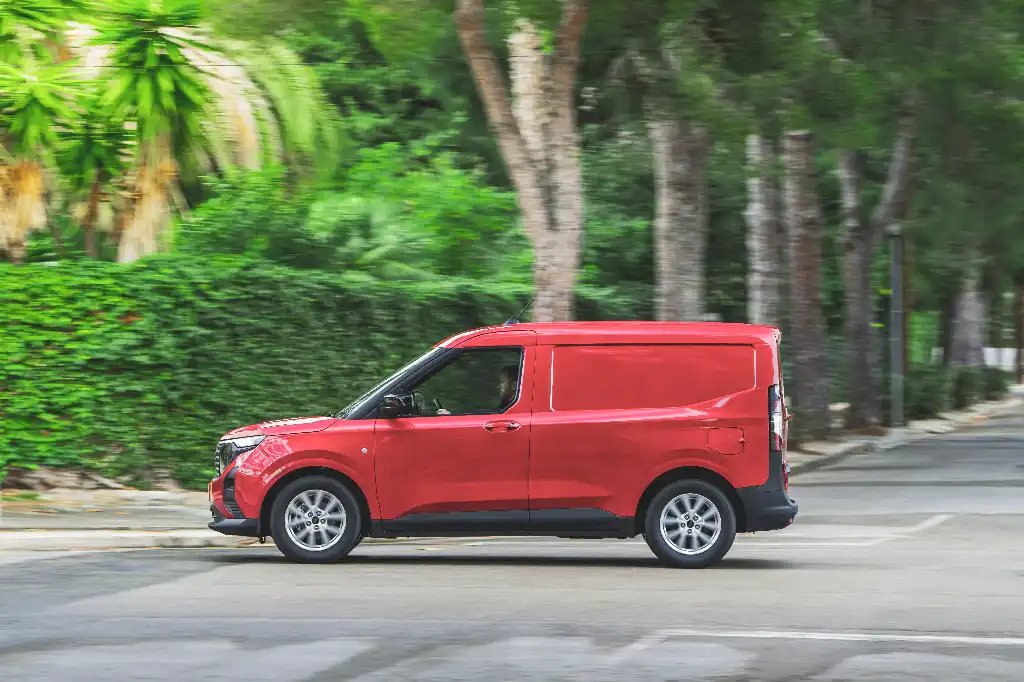
Yes. It's more than good actually. It's a fantastic handling little van for a number of reasons. Ford has always produced good vans to drive, but when it comes to small vans they're particularly good. That has a lot to do with it being a relation to the Puma.
The Transit Courier's steering is quite heavy, but not in a bad way. There's far more feeling to it than in other small vans like the Citroen Berlingo. It's also totally different to the very light and assisted steering you get in a Volkswagen Caddy. And is worth noting that the Transit Connect shares the Caddy's platform, so the Courier is Ford's best handling small van.
It's well suited as both a city van or for motorways.
The ride is slightly firm, but more forgiving that your average commercial vehicle. In comparison to the Tourneo Courier passenger van, the Transit version is firmer still. That's because it has higher rated rear suspension to cope with heavy loads. It's noticeable when driven back-to-back but not so much that the Transit van feels worse off.
With a reasonable payload it is perfectly suited all manner of road surfaces.
Although there is a small amount of body roll into corners it's not enough to make the van feel unstable. The front end does understeer a little bit but it's only noticeable when the hammer is really down. It certainly doesn't alter the enjoyment of its driving abilities.
Yes, the Ford Transit Courier is one of the most economical Ford vans on the market. Fuel economy for petrol vans ranges from 38.1mpg to 43.5mpg, while diesel Ford Transit Courier vans have an official WLTP fuel economy figure of 51.4mpg to 55.4mpg.
The Transit Courier gets four trim levels. Leader, Trend, Limited and Active. Leader is the very well stocked start to the range.
Standard Interior & Exterior Equipment:
The next trim up Trend gets fog lamps, quickclear windscren a single sliding door (left side), manual air conditioning, heating seat and steering wheel, amongst the add-ons.
The range-topping Active looks more sophisticated than the other vans with a honeycomb mesh grille and larger 17in alloys. It also gets silver painted roof rails, one-touch windows on both sides and a wireless charging pad. But one tier below, the Limited models get more important and useful stuff.
This includes front parking sensors, digital rear camera and keyless entry.
For that reason, the Limited is probably the best equipped model in the range - if you want a lot of kit. But, the Leader has so much equipment it is a very good starting point.
Safety equipment is amongs the best in its class. The Courier gets driver, passenger and curtain airbags as standard. There are then many driver assistance systems including emergency braking, cruise control, intelligent speed assist, lane keeping and hill hold.
Higher trim levels like Limited and Active provide more parking sensors. But there's a reverse parking aid as standard.

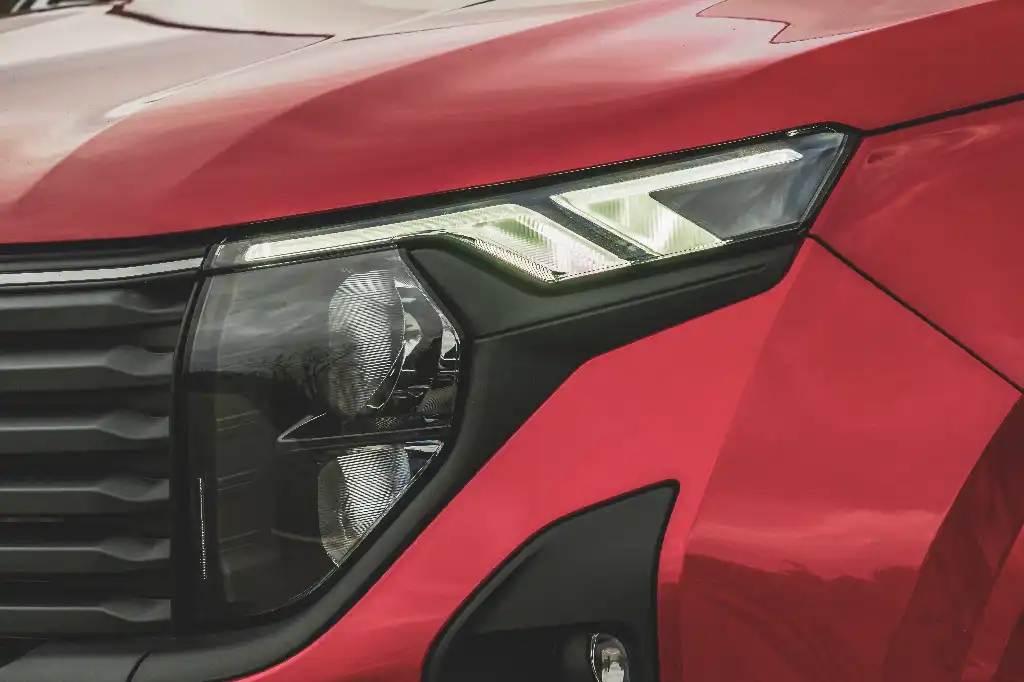
Unless you have a particularly good reason to buy the petrol van, diesel is the way to go. We prefer the six-speed manual gearbox over the auto - but the auto is very good. It has a great shift action and gives the van a slightly sporty feel. Diesel vans have the power and torque needed to be a proper working van. The petrol is pretty pathetic at pulling away.
Don't forget that diesel also has the added bonus of being more fuel efficient.
When it comes to trim levels, we'd suggest looking at entry-level leader and considering what you'd miss. We don't think it would be much. If you have money to spare then the range-topping Active trim is of course the nicest van to be in. But nothing much changes in appearance on the inside, you just get more tech.
However you look at it, you will still be saving money compared to similar competitors like the Berlingo, Partner, Combo or Kangoo. Starting prices for those vans are at least 30% more.
Ford has crammed a lot into the Courier. Not only is its price attractive but its size is too. It will suit city van buyers that don't need huge amounts of space. But also those that want high payloads as the additional option of a higher GVW adds weight carrying potential.
There's an adundance of choice, excellent value standard safety systems and a fantastic levels of comfort and driving.